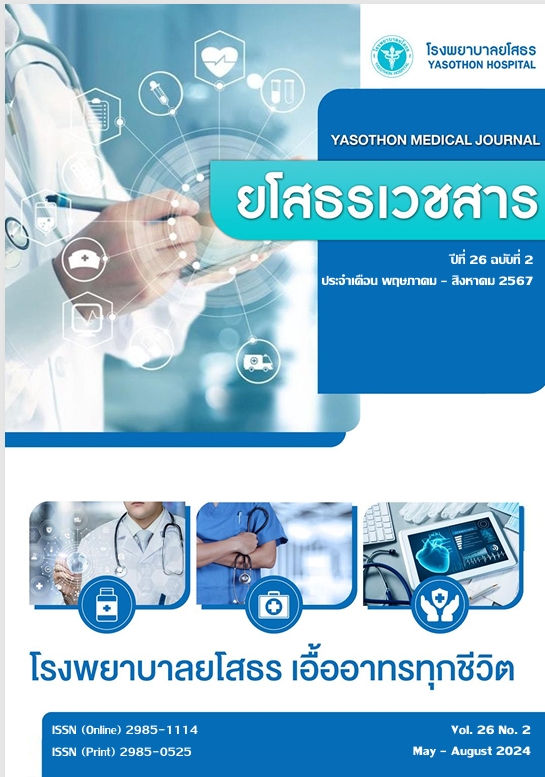Develop a Nursing Model for Pediatric Thalassemia Patients Yasothon Hospital
Keywords:
Nursing Model, Pediatric Thalassemia Patients, Pediatric Thalassemia Patients Receiving BloodAbstract
This research is a research and development with the objective of developing a nursing model for thalassemia children at Yasothon Hospital. The study was conducted from January 2022 to October 2022. There were 4 phases; Phase 1: Study the situation; Phase 2: Develop a nursing model; Phase 3: Trial and Phase 4: Evaluation. The sample groups were purposively selected as follows: 1) Service recipients: 60 caregivers of thalassemia children and thalassemia children; 2) Service providers: 10 professional nurses. The research instruments were: 1) The new manual for nursing standards for thalassemia children; 2) the instruments used for data collection were: (1) a recording form for nursing indicators before, during and after blood transfusion. (2) Personnel satisfaction questionnaire (3) Knowledge measurement form for caregivers of thalassemia children (4) Patient satisfaction questionnaire. Data were analyzed using descriptive statistics and inferential statistics to compare the difference in mean scores before and after providing knowledge using paired t-test statistics.
The results of the study found that 1) Nursing care model for pediatric thalassemia patients consists of nursing standards for children with thalassemia and health education videos for thalassemia 2) The effectiveness of the system consists of service provider results, including overall personnel satisfaction at a very high level ( = 4.97, S.D. = 0.37) and compliance with nursing standards It was in the range of 88.7-100 percent. Results for service users included complications from blood transfusions. The knowledge of caregivers after development was significantly higher than before development ( before = 8.52, after = 14.67) significantly at the .01 (p-value= .000), and patient satisfaction. The overall level is at a very high level ( = 4.98, S.D. = 0.04)
References
วรวรรณ ตันไพจิตร. โรคธาลัสซีเมีย. กรุงเทพมหานคร: ศิริยอดการพิมพ์; 2540.
พงษ์จันทร์ หัตถีรัตน์, ภัทรพร อิศรางกูร ณ อยุธยา, อำไพวรรณ จวนสัมฤทธิ์. โลหิตวิทยาในเด็ก. พิมพ์ครั้งที่ 3. กรุงเทพฯ: หน่วยโลหิตวิทยา ภาควิชากุมารเวชศาสตร์ คณะแพทยศาสตร์ โรงพยาบาลรามาธิบดี; 2538. หน้า 71-90.
วิปร วิประกษิต.“ธาลัสซีเมีย”: การดูแลรักษาโรคโลหิตจางธาลัสซีเมียแบบบูรณาการ. วารสารโลหิตวิทยาและเวชศาสตร์บริการโลหิต ตุลาคม-ธันวาคม 2556; 23 (4): 303-20.
สุทัศน์ ฟู่เจริญ, ปราณี ฟู่เจริญ. Thalassemia and hemoglobinopathies. ใน: ถนอมศรี ศรีชัยกุล, แสงสุรีย์ จูฑา, บรรณาธิการ. ตำราโลหิตวิทยา: การวินิจฉัยและการรักษาโรคเลือดที่พบบ่อยในประเทศไทย. พิมพ์ครั้งที่ 2. กรุงเทพฯ: เมดิคัล มีเดีย; 2537. หน้า 202-42.
พยอม อิงคตานุวัฒน์, ศุภาสินี กังวาลเนาวรัตน์. สภาวะจิต-สังคมในเด็กเป็นโรคธาลัสซีเมีย. วารสารสมาคมกุมารแพทย์แห่งประเทศไทย 2522; 18: 25-47.
กาญจนา จันทร์สูง. แนวทางการให้เลือดและส่วนประกอบของเลือด. ศรีนครินทร์เวชสาร กรกฎาคม-กันยายน 2543; 15(3): 215-24.
ประกริต รัชวัตร์, นัยนา ภูลม. ปัจจัยที่มีอิทธิพลต่อคุณภาพชีวิตผู้ป่วยเด็กธาลัสซีเมีย. วารสารวิจัยและพัฒนาระบบสุขภาพ มกราคม-เมษายน 2565; 15(1): 334-49.
กลุ่มงานกุมารเวชกรรม. สรุปข้อมูลการให้บริการของหอผู้ป่วยกุมารเวชกรรมในโรงพยาบาลยโสธรประจำปี. ยโสธร: โรงพยาบาลยโสธร; 2564.
Donabedian A. An introduction to quality assurance in health care. New York: Oxford University Press; 2003.
นงพรรณ พิริยานุพงศ์. คู่มือวิจัยและพัฒนา. นนทบุรี: โครงการสวัสดิการวิชาการ สถาบันพระบรมราชชนก; 2546.
พุทธวร พิลาฤทธิ์, ศุภลดา ถาแสนทรัพทย์. การพัฒนารูปแบบการดูแลผู้ป่วยเด็กธาลัสซีเมีย โรงพยาบาลโพนพิสัย จังหวัดหนองคาย. วารสารวิจัยสุขภาพ โรงพยาบาลชุมชน กันยายน-ธันวาคม 2566; 1(3): 153-65.
Downloads
Published
How to Cite
Issue
Section
License
Copyright (c) 2024 Yasothon Medical Journal

This work is licensed under a Creative Commons Attribution-NonCommercial-NoDerivatives 4.0 International License.
บทความที่ได้รับการตีพิมพ์เป็นลิขสิทธิ์ของยโสธรเวชสาร







